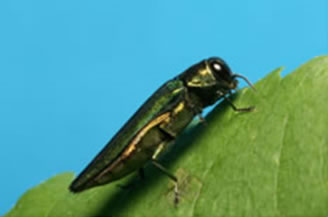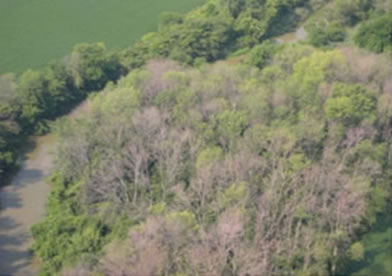Emerald ash borer
The emerald ash borer (Agrilus planipennis) is a species of metallic wood-boring beetle native to East Asia, including China and the Russian Far East.
Most species of North American ash trees are very vulnerable to this beetle, which has killed millions of trees in Canada in forested and urban areas.
No North American natural predators, such as woodpeckers, other insects or parasites have been able to slow the spread of the emerald ash borer or keep trees from being killed by it.
Quick facts
- The emerald ash borer likely arrived in North America on wood packaging materials in the early 1990s.
- First detected near Detroit, Michigan and Windsor, Ontario in 2002, the beetle has spread to more than 30 states and 5 provinces since then.
- Populations exist in Winnipeg (Manitoba); Sault Ste. Marie, the Algoma District and Thunder Bay (Ontario); Quebec City (Quebec); Halifax (Nova Scotia); Edmunston and as of August 2019, Oromocto (New Brunswick).
- Up to 99% of all ash trees are killed within 8-10 years once the beetle arrives in an area.
- Adults can fly and spread locally.
- The moving of infested material causes long distance spread as does adult beetles hitchhiking on vehicles.

Emerald ash borer (adult).
Impacts
Emerald ash borer infestations cause significant ecological and economic impacts in forested and urban habitats.
- In forest habitats, losing the majority of ash trees can affect tree species composition, natural forest succession, and nutrient cycling. Habitats also become more vulnerable to invasion by exotic plants.
- After an infestation remaining beetles can kill new growth, jeopardizing forest recovery.
- In urban areas, infestations have killed tens of thousands of ash trees planted in parks and along streets.
- Municipal governments are responsible for removing dead ash trees on urban land. Ash trees that are affected should be chemically treated or removed and replaced, which can be a significant economic burden.
- Losing urban canopy can increase homeowner heating/cooling costs and can affect people with health issues such as respiratory illnesses.
CFS scientific research
Research conducted by scientists at the Canadian Forest Service (CFS) has greatly expanded what is known about the emerald ash borer since it was detected in 2002. This work includes:
- developing sampling and monitoring tools including pheromone-based traps and branch sampling for detecting new infestations;
- developing economic models to support decision making by urban foresters;
- conducting biological control research to introduce parasitic wasp species from the beetle’s native range in China and Russia into Canada;
- investigating a biological control that infects beetles with a naturally occurring fungus, which then spreads to other beetles;
- developing the botanical insecticide TreeAzin®.

Ariel view of ash trees severely damaged by the emerald ash borer.
Working collaboratively to develop solutions
Natural Resources Canada, through work conducted at its Canadian Forest Service (CFS), provides knowledge, tools and techniques to support clients and stakeholders to manage the emerald ash borer effectively.
This work is coordinated among three CFS laboratories – the Great Lakes Forestry Centre, the Atlantic Forestry Centre, and the Laurentian Forestry Centre – in collaboration with the Canadian Food Inspection Agency, the U.S. Department of Agriculture (U.S. Forest Service and the Animal and Plant Health Inspection Service), provincial and municipal governments, conservation authorities, Canadian and American universities and private partners.
Have questions?
Send questions or comments to CFS Questions with “emerald ash borer” in the subject heading.
- Canadian Food Inspection Agency (CFIA) – Emerald ash borer
- Canada Border Services Agency (CBSA) – Protecting Canada from invasive species
- University of Minnesota - Webinar on the emerald ash borer (2017)
Page details
- Date modified: